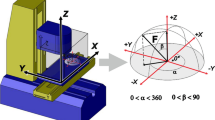Abstract
Due to the advancements in high speed and high performance cutting, further improvements of machine component design and process monitoring are necessary. For this purpose, new machine components with process monitoring capabilities have to be developed. In this paper, a new spindle carrying Z-slide for a 5-axis machining center with integrated sensing capabilities for process monitoring is presented. First, the overall system design is described. The sensing capabilities to enable process monitoring are realized by application of a micro-strain gauges network on to the structure of the slide. The optimal sensor positions are computed by application of a special sensor placement algorithm. The prototype of the slide has been built up to investigate the system behavior. The electronic system of the prototype to realize the signal amplification and the communication via an industrial bus are presented. Furthermore, the results of the system analysis of the prototype are described. Because the sensor amplitudes, which can be monitored by strain gauges on stiff structures, are generally small, a method to increase these amplitudes by use of the notch effect and new micro-strain sensors is discussed. With this method, the signal amplitudes can be increased significantly, without degrading the stiffness noticeably. At the end of the paper a method to manufacture notches in the prototype by a milling process is presented. The surface roughness of plan notch ground, measured with a laserprofilometer, shows roughness values lower than 3 μm.












Similar content being viewed by others
References
Brinkhaus J-W (2009) Statische Verfahren zur selbstlernenden Überwachung spanender Bearbeitung in Werkzeugmaschinen. Dr.-Ing, Diss. Leibniz Universität Hannover
Denkena B, Brinkhaus JW, Lange D (2005) Possibilities of sensor transponders in machine tools. In: 10th international scientific conference on production engineering, computer integrated manufacturing and high speed machining
Denkena B, Mohring H-C, Litwinski KM (2008) Design of dynamic multi sensor systems. Prod Eng Res 3:327–331
Düsing JF, Suttmann O, Klug U, Kling R, Litwinski K, Möhring H-C, Denkena B (2010) Neue Ansätze für die Produktionstechnik durch bauteilinhärente Sensorik. Produktion von Leiterplatten und Systemen, Band 12:2887–2892
Griesbach T, Wurz MC, Rissing L (2011) Application of sacrificial layers for the modular micro sensor fabrication on a flexible polymer substrate. Sensor, Nurnberg
Hesselbach J, Hoffmeister H, Schuller B, Loeis K (2010) Development of an active clamping system for noise and vibration reduction. The Int Acad for Prod Eng Anna 59:395–398
Kim GD, Know WT, Chu CN (1999) Indirect cutting force measurement and cutting force regulation using spindle motor current. Int J manuf sci technol 1, 1
Kim T-Y, Woo J, Shin D, Kim J (1999) Indirect cutting force measurement in multi-axis simultaneous NC milling processes. Int J Mach Tools Manuf 39:1717–1731
Leopold J, Clauß D, Klärner M, Poppitz A, Baldoli M, Merlo A, Gimenez M, Larranaga J (2007) Investigations to new fixturing principles for aerospace structures. In: APT 07, international conference on applied production technology, S. 173–S.189
Litwinski KM (2011) Sensorisches Spannsystem zur Überwachung von Zerspanprozessen in der Einzelteilfertigung. Dissertation, Leibniz Universität Hannover, Dr.-Ing
Möhring H-C, Litwinski KM, Gümmer O (2010) Process monitoring with sensory machine tool components. The Int Acad Prod Eng Anna–Manuf Technol 59:383–386
Neuber H (1985) Kerbspannungslehre. Springer, Heidelberg
Overmeyer L, Dumke M, Heiserich G, Franke S, Schulz L (2010) Power transmission by optical fibers for component inherent communication. J Syst Cybern Inf 8:55–60
Rashid A, Nicolescu CM (2006)) Active vibration control in palletized workholding system for milling. Int J Mach Tools Manuf 46(12/13):S.1626–S.1636
Yao Z, Mei D, Chen Z (2010) Online chatter detection and identification based on wavelet and support vector machine. J Mater Process Technol 210(5):713–719
Acknowledgments
The authors want to thank the German Research Foundation (DFG) for funding this research within the collaborative research centre 653: Gentelligent Components within their lifecycle.
Author information
Authors and Affiliations
Corresponding author
Rights and permissions
About this article
Cite this article
Denkena, B., Litwinski, K.M., Brouwer, D. et al. Design and analysis of a prototypical sensory Z-slide for machine tools. Prod. Eng. Res. Devel. 7, 9–14 (2013). https://doi.org/10.1007/s11740-012-0419-1
Received:
Accepted:
Published:
Issue Date:
DOI: https://doi.org/10.1007/s11740-012-0419-1




